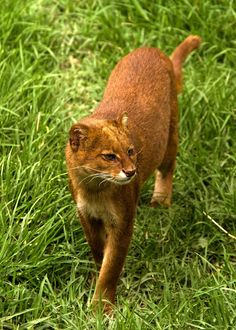Jaguar ~ Sage Massey
JAGUAR
RECOVERY PLAN
Sage Massey
Wildlife
Biology and Conservation
November 8,
2017
Description
and Ecology of Organism
Jaguars
usually have a tan coat with black spots or rosettes over their whole body,
however, some have reddish-brown or solid black coat. Their underbelly, throat,
and flanks are white.
The Jaguar
is the largest cat in the Americas, third largest in the world just behind the
lion and tiger. They typically weigh around 80 pounds however larger ones have
been recorded to weigh between 288 – 333 pounds. They are 5.3 – 6 feet long and
stand about 27 – 30 inches tall at the shoulders. Their tail alone is 2 – 3
feet long.
Habitat
Jaguars
live in places where grasslands are vast and most of the plant life consists of
shrubs and few trees. However, the main population lives in rainforests like
the Amazon where abundant trees grow in and around swamps. Regardless of their
location Jaguars tend to always live in dens in the mouth of caves where water
is only a short distance away.
Diet
The jaguar, is a carnivore preying on animals such as: deer, crocodiles, livestock, snakes, monkeys,
turtles, eggs, frogs, fish and anything else they can catch.
Using their spotted coat as camouflage and dense muscled
bodies, the jaguar hunts wild animals weighing up to 660 pounds. Even reported
that an individual jaguar can drag an 800-pound bull in its jaws.
While most of their hunting is done on the ground in speedy
chases, they are also known to hide in trees above and pounce on their prey as
it passes under the branches.
Powerful jaws allow
them to kill an animal with one swift bite to the head, crushing their skull
and causing a fatal blow to the brain.
If the predator isn’t ready for his mean he will save it for
later by burring it for safe keeping.
Geographic and Population Changes
Currently,
jaguars are found in 19 countries:
Argentina, Belize, Bolivia, Brazil, Colombia, Costa Rica, Ecuador,
French Guiana, Guatemala, Guyana, Honduras, Mexico, Nicaragua, Panama,
Paraguay, Peru, Suriname, United States, and Venezuela. Recently, there have
been sightings of Jaguars in southern Arizona and New Mexico.
Populations
have been dwindling since around 1950. Jaguars only inhabit about 40% of their
original, historical range. In the mid-1800s the jaguar population extended from
Southern Brazil all the way to Central America and even some in the Western US,
north all the way to the Grand Canyon. There was an estimated 300,000 to 400,000
jaguars roaming in the wild. However, in the 1960s and 1970stheir population
began to decline, approximately 18, 000 jaguars were killed each year. By 1996,
jaguars in the United States were almost nonexistent. Today it is estimated
that only 15, 000 jaguars remain in the wild. Those that have survived are
being protected by the Convention on International Trade in Endangered Species
of Wild Fauna and Flora since 1973.
Listing Date and Type of Listing
The jaguar is listed as endangered under the Endangered
Species Act of 1973. Jaguars are listed as “Near Threatened” on the
International Union for the Conservation of Nature (IUCN) Red List of
Threatened Species.
Cause of listing and Main threats to
its existence
Jaguars are an endangered species due to loss of habitat and
over-hunting by man to put in plainly.
Hunting of Jaguars:
Because prey is limited at time Jaguars will hunt livestock;
however, this backfires severely on the cat. Ranchers losing thousands of
dollars when their cattle are killed encouraged hunting of the endangered
species in 2001. The Jaguar population decreased rapidly, making hunting one of
the top reasons they are endangered.
Loss of habitat:
Farms, ranches, mines, roads, towns, residential subdivisions
and border infrastructure are increasingly being built in areas important to
jaguar survival, destroying jaguar habitat and blocking migration routes.
Depletion of prey:
This runs hand in hand with habitat loss the decreasing of
habitat not only mean diminishing jaguar population but loss of pry animals as
well.
Description of Recovery Plan
Recovery Plan was
published December 20th of 2016, they are in stage D of their plan,
in progress but no implementation information so far.
The
Recovery Plan from the US Fish and Wildlife Services is as follows:
1) Ascertain the status and conservation needs
of the jaguar.
2) Assess and maintain or improve genetic
fitness, demographic conditions, and the health condition of the animal.
3) Assess and maintain or improve the status of
native prey populations.
4) Assess, protect, and restore quantity,
quality, and connectivity of habitat to support viable populations of jaguars.
5)
Assess, minimize, and mitigate the effects of expanding human
development on jaguar survival and mortality where possible.
6)
Minimize direct human-caused mortality of jaguars.
7)
Ensure long-term jaguar conservation through adequate funding, public
education and outreach, and partnerships.
8)
Practice adaptive management in which recovery is monitored and recovery
tasks are revised by the USFWS in coordination with the JRT as new information
becomes available.
Recovery
Goals
The
goal of this revised recovery plan is to recover and delist the jaguar, with
downlisting from endangered to threatened status as an intermediate goal.
Expansive open spaces in the southwestern U.S. of at least
100 km2 (38.6 mi2) in size, which:
1) Provide connectivity to Mexico.
2) Contain adequate levels of native prey species, including
deer and javelina, as well as medium-sized prey such as coatis, skunks,
raccoons, or jackrabbits,
3) Include surface water sources available within 12.4 miles
of each other.
4) Contain from greater than 1 to 50 percent canopy cover
within Madrean evergreen woodland, or semidesert grassland vegetation
communities.
5) Are characterized by intermediately, moderately, or
highly rugged terrain.
6) Are below 6,562 feet in elevation.
7) Are characterized by minimal to no human population
density, no major roads, or no stable nighttime lighting.
What can you do?
If you visit Defenders of Wildlife
there are several ways you can help such as: Adopting a Jaguar,
staying informed, speaking up for wildlife, becoming a wildlife defender, and
more.
Visit their website:
World Land Trust has many ways you can help save the
rainforest including buying acres, planting trees, donations, as well as many
other options. Saving the rainforest is critical for the jaguars future.
Follow the link:
There are many more groups you can donate to, even if it
small every bit counts!
resources
To see the Recovery Plan from the US
Fish and Wildlife Services visit the link below:
For more facts about the Jaguar visit these websites:
Pictures
http://www.somepets.com/wp-content/uploads/2014/07/Jaguar-hunting-prey.jpg









You provided a good amount of detail throughout your blog. Using stats to give the reader a better idea of what is actually happening to the jaguar populations was a great idea. I liked that you gave numerous options of what the reader could do to help.
ReplyDelete-Mckenna Moura
Super cool animal. I love the first picture and the simplicity of your information. Good explanation about each of the threats. Very interesting recovery plan. Cool to learn about ways to expand the habitat, by providing connectivity to Mexico.
ReplyDelete-Perry Nalle
This comment has been removed by the author.
ReplyDeleteFor starters, you did a great job of including such captivating photos of this interesting animal. I also liked your spatial organization and thought you did a good job of talking about their population and what we can do to help.
ReplyDelete-Parker Ornellas
Great post on the Jaguar! I hadn't realized before how powerful this animal is and that it hunts crocodiles, very impressive and good provocative photo of that. The hunting of jaguars by ranchers that consider them pests reminds me of the documentary we watched on elephants and the villagers there thinking about elephants in a similar manner. Well done!
ReplyDelete-Shannon O'Hehir
The post was really interesting! Especially referring to the different kinds of coats that a jaguar possesses. I learned a lot and you were very thorough on recovery plans of the jaguar.
ReplyDelete-Christine Okimura
Super interesting information on the diet of the jaguar! I can't believe that it has the ability to drag animals of 800 pound with their jaws. That is amazing! Beautiful images of the jaguars as well.
ReplyDelete-Fiona McCallion
This post has a lot of information and is really easy to understand! It was interesting to learn about the jaguar's diet, as well as how the development of roads and towns are threatening the jaguar.
ReplyDelete-Kristen Nagamatsu
I find it very interesting that while jaguars are hunted due to their predation on cattle, their other main threat is habitat loss due to land use and more ranchers moving in and bringing in more cattle.
ReplyDelete-Bryn Mulligan
While jaguars are portrayed in stories and childrens movies, I never knew much about them. Very informative blog, the image of one with the crocodile is incredible. I hope we can recover this animal.
ReplyDelete-Ali Murray